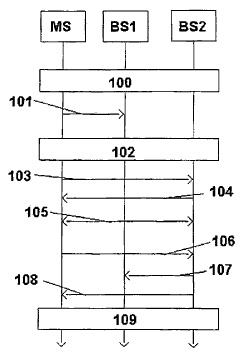 HTC Corp v. IPCom GMBH, Dkt. No. 2011-1004 (Fed. Cir. Jan 30, 2012) [PDF].
HTC Corp v. IPCom GMBH, Dkt. No. 2011-1004 (Fed. Cir. Jan 30, 2012) [PDF].
HTC sue IPcom for declaratory judgement of non-infringement of IPCom’s Patents, including U.S. Pat. No. 6,879,830 and IPCom countersued for infringement. The ‘830 patent is directed to the handover of a cellular phone from one base (tower) to another, as for example, when a person uses a cell phone in a car traveling between coverage areas.  The invention is intended to reduce the chance of service interruption during the handover.
Claim 1 provides:
A mobile station for use with a network including a first base station and a second base station that achieves a handover from the first base station to the second base station by:
storing link data for a link in a first base station,
holding in reserve for the link resources of the first base station, and
when the link is to be handed over to the sec-ond base station:
initially maintaining a storage of the link data in the first base station,
initially causing the resources of the first base station to remain held in reserve, and
at a later timepoint determined by a fixed pe-riod of time predefined at a beginning of the handover, deleting the link data from the first base station and freeing up the resources of the first base station, the mobile station comprising:
an arrangement for reactivating the link with the first base station if the handover is unsuc-cessful.
At summary judgement, HTC claimed that claims 1 and 18 (similar to claim 1), were invalid as indefinite because (1) they claimed both an apparatus and method steps and (2) the patent failed to disclose structure corresponding to the claimed means-plus-function element “arrangement for reactivating.”
Over Emphasis on Prosecution History. While the district court found the claims invalid because they claimed both apparatus and method steps, the Federal Circuit disagreed.  The Federal Circuit found the claim was an apparatus claim directed to a moble station (cellular phone) to be used within a network. In interpreting the claim language the Federal Circuit considered factors set out in Phillips v. AWH Corp., 415 F.3d 1303 (Fed. Cir. 2005) (en banc): (1) the words of the claim, (2) the specification, (3) the prosecution history, and (4) extrinsic evidence. The Federal Circuit found that the district court put too much emphasis on the prosecution history. The patentee in response to an office action stated, “the cited section of [the prior art reference] clearly describes a process that is completely different from the claimed process. . .” (emphasis added). The Federal Circuit  noted that “claim language and the specification generally carry greater weight than the prosecution history.” The court found that the attorney’s signle reference to a “process” in response to an office action was insufficient when viewed in relation to the plain language of the claims and specification.
Sufficient Computer Structure. The Federal Circuit found that the district court erred in finding that the disclosure of a processor and transceiver was sufficient structure. The Federal Circuit noted that when considering whether their is sufficient support in the specification for a means-plus-function limitation, the disclosure of a general purpose computer or micro processor is not enough. Instead an algorithm must also be disclosed which the computer/processor executes. A patent must disclose “a means for achieving a particular outcome, not merely the outcome itself.” Yet, the appellate court found HTC waived any argument regarding whether the ‘830 patent disclosed a sufficient algorithm.
Further, the Federal Circuit rejected HTC’s argument that the specification needed to disclose the precise circuitry, components, or schematics or controllers would be employed. The court provided that level of hardware disclosure is not necessary, stating “as long as a sufficient algorithm describing how a general-purpose computer will perform the function is disclosed, reference to such general-purpose processors will suffice to overcome an indefiniteness challenge.”